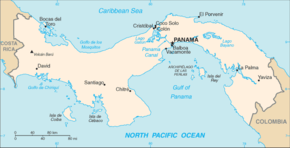
Back Panamakanaal Afrikaans Panamakanal ALS ፓናማ ቦይ Amharic Canal de Panamá AN قناة بنما Arabic قناة باناما ARZ পানামা খাল Assamese Canal de Panamá AST पनामा नहर AWA Panama kanalı Azerbaijani
| Panama Canal Canal de Panamá | |
|---|---|
 A schematic of the Panama Canal, illustrating the sequence of locks and passages | |
 | |
| Coordinates | 9°7′12″N 79°45′0″W / 9.12000°N 79.75000°W |
| Specifications | |
| Length | 82 km (51 miles) |
| Maximum boat length | 366 m (1,200 ft 9 in) |
| Maximum boat beam | 49 m (160 ft 9 in) (originally 28.5 m or 93 ft 6 in) |
| Maximum boat draft | 15.2 m (50 ft) |
| Maximum boat air draft | 57.91 m (190.0 ft) |
| Locks | 3 locks up, 3 down per transit; all three lanes (3 lanes of locks) |
| Status | Opened in 1914; expansion opened 26 June 2016 |
| Navigation authority | Panama Canal Authority |
| History | |
| Principal engineer | Armand Reclus and Gaston Blanchet (1881–1882), Jules Dingler (1883-1885), Maurice Hutin (1885), Philippe Bunau-Varilla (1885-1886, acting), Léo Boyer (1886), M. Nouailhac-Pioch (1886, acting), M. Jacquier (1886-1889), Philippe Bunau-Varilla (1894-1903), John Findley Wallace (1904–1905), John Frank Stevens (1905–1907), George Washington Goethals (1907–1914) |
| Construction began | 1 January 1881 |
| Date completed | 15 August 1914 |
| Date extended | 26 June 2016 |
| Geography | |
| Start point | Caribbean Sea (part of Atlantic Ocean) |
| End point | Pacific Ocean |
| Connects to | Pacific Ocean from Atlantic Ocean and vice versa |

The Panama Canal (Spanish: Canal de Panamá) is an artificial 82-kilometer (51-mile) waterway in Panama that connects the Caribbean Sea with the Pacific Ocean. It cuts across the narrowest point of the Isthmus of Panama, and is a conduit for maritime trade between the Atlantic and Pacific Oceans. Locks at each end lift ships up to Gatun Lake, an artificial fresh water lake 26 meters (85 ft) above sea level, created by damming the Chagres River and Lake Alajuela to reduce the amount of excavation work required for the canal. Locks then lower the ships at the other end. An average of 200 ML (52,000,000 US gal) of fresh water is used in a single passing of a ship.[1] The canal is threatened by low water levels during droughts.
The Panama Canal shortcut greatly reduces the time for ships to travel between the Atlantic and Pacific oceans, enabling them to avoid the lengthy, hazardous route around the southernmost tip of South America via the Drake Passage, the Strait of Magellan or the Beagle Channel. Its construction was one of the largest and most difficult engineering projects ever undertaken. Since its inauguration on August 15, 1914, the canal has succeeded in shortening maritime communication in time and distance, invigorating maritime and economic transportation by providing a short and relatively inexpensive transit route between the two oceans, decisively influencing global trade patterns, boosting economic growth in developed and developing countries, as well as providing the basic impetus for economic expansion in many remote regions of the world.[2]
Colombia, France, and later the United States controlled the territory surrounding the canal during construction. France began work on the canal in 1881, but stopped in 1889 because of a lack of investors' confidence due to engineering problems and a high worker mortality rate. The US took over the project in 1904 and opened the canal in 1914. The US continued to control the canal and surrounding Panama Canal Zone until the Torrijos–Carter Treaties provided for its handover to Panama in 1977. After a period of joint American–Panamanian control, the Panamanian government took control in 1999. It is now managed and operated by the Panamanian government-owned Panama Canal Authority.
The original locks are 33.5 meters (110 ft) wide and allow the passage of Panamax ships. A third, wider lane of locks was constructed between September 2007 and May 2016. The expanded waterway began commercial operation on 26 June 2016. The new locks allow for the transit of larger, Neopanamax ships.
Annual traffic has risen from about 1,000 ships in 1914, when the canal opened, to 14,702 vessels in 2008, for a total of 333.7 million Panama Canal/Universal Measurement System (PC/UMS) tons. By 2012, more than 815,000 vessels had passed through the canal; in that year, the United States, China, Chile, Japan, and South Korea were the top five users of the canal.[3][4] In 2017, it took ships an average of 11.38 hours to pass between the canal's two outer locks. The American Society of Civil Engineers has ranked the Panama Canal one of the Seven Wonders of the Modern World.[5]
- ^ "Location, location, location – Why the Panama Canal matters". Wallenius Wilhelmsen. 2 September 2024. Retrieved 16 December 2024.
- ^ Autoridad del Canal de Panamá. "Así es el Canal". Archived from the original on 6 May 2009. Retrieved 2 August 2009.
Buques de todo el mundo transitan a diario a través del canal de Panamá. Entre 13 mil y 14 mil barcos utilizan, cada año, el canal. De hecho, las actividades de transporte comercial a través del canal representan alrededor del 5 % de comercio mundial.
- ^ "Panama Canal Traffic—Years 1914–2010". Panama Canal Authority. Archived from the original on 30 December 2010. Retrieved 25 January 2011.
- ^ Autoridad del Canal de Panamá – Oficina de investigación y análisis de mercado (15 October 2012). "Jerarquización de países por flujo de carga a través del canal de Panamá – Año fiscal 2012 (Toneladas largas)" (PDF). Archived from the original (PDF) on 1 February 2014. Retrieved 6 June 2013.
- ^ "Seven Wonders". American Society of Civil Engineers. Archived from the original on 2 August 2010. Retrieved 21 February 2011.